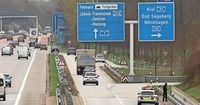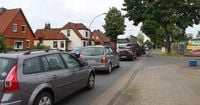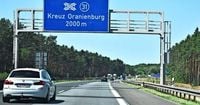Traffic congestion is a common concern for motorists in Germany, and recent reports from various regions highlight the current situations on major highways and roads. On April 4, 2025, comprehensive traffic updates were provided for Nienburg, Lübeck, Oberhavel, and Gifhorn, revealing the ongoing challenges faced by drivers across these areas.
In Nienburg, the traffic situation has been closely monitored, particularly on highways A2, A37, A7, A27, and A1, as well as federal roads including B6, B215, B214, B482, B62, B239, B51, B442, and B441. According to reports from the HARKE, the traffic updates are sourced from TomTom, a navigation system manufacturer that utilizes GPS data from millions of devices. This data is refreshed every five minutes, ensuring that motorists are kept informed of any significant delays or accidents.
TomTom's data collection involves automatic information from approximately 80 million mobile devices and several million official road sensors, complemented by manually maintained updates. This combination of sources aims to enhance the accuracy of traffic reports. The HARKE emphasizes the importance of being considerate towards other road users, reminding drivers to remain vigilant.
Moving north to Lübeck, traffic conditions are similarly challenging. The LN-Staumelder provides insights into congestion on highways A1, A20, and A226, as well as federal roads B75, B207, and B104. The ADAC has indicated that the A1 and A7 are particularly prone to traffic jams, especially during peak tourist seasons. The A1, which connects Hamburg with various coastal towns and runs through Stormarn and past Lübeck to Fehmarn, often experiences heavy traffic during busy periods.
The data for Lübeck, like that of Nienburg, is also derived from TomTom. The updates are delivered every five minutes, ensuring that drivers have access to the latest information on road conditions. As with the Nienburg report, the importance of road safety and consideration for fellow motorists is stressed.
In Oberhavel, the MAZ-Staumelder highlights traffic issues on highways A10, A24, and A111, along with federal roads B96, B167, and B109. Specific problem areas include the A111 at the Oranienburg interchange and the A24 stretch from Kremmen to Fehrbellin. The report outlines that the data comes from the same reliable sources, including TomTom, and is updated frequently to provide accurate information to drivers.
Oberhavel's report also emphasizes the necessity for drivers to be cautious, particularly on busy roads that can quickly become congested. The MAZ report underscores the relevance of using technology to stay informed about traffic conditions, especially in an area where roadwork and accidents can lead to unexpected delays.
Lastly, in Gifhorn, the AZ-Staumelder reports on traffic conditions along highways A2 and A39, as well as federal roads B188, B4, B214, B248, and K114. The traffic situation in Gifhorn reflects similar trends observed in the other regions, with a focus on ensuring that motorists are aware of potential slowdowns. The data, sourced from TomTom, is again updated every five minutes, maintaining a high level of accuracy.
As with the previous regions, the AZ-Staumelder encourages drivers to stay alert and considerate while navigating busy roads. The commitment to providing timely traffic updates is crucial for helping drivers make informed decisions about their routes.
In summary, the traffic reports from Nienburg, Lübeck, Oberhavel, and Gifhorn reveal a consistent reliance on TomTom's data to inform the public about current road conditions. With traffic congestion being a common issue, the emphasis on using technology to provide real-time updates is vital. Whether it’s through the HARKE, LN-Staumelder, MAZ-Staumelder, or AZ-Staumelder, the goal remains the same: to keep motorists safe and informed.
As drivers navigate these busy regions, they are reminded of the importance of being considerate to other road users, especially during peak traffic times. With the aid of modern technology and regular updates, the hope is that road conditions will improve, allowing for smoother travel across Germany's highways and roads.







